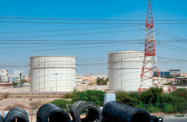Oman has sought to encourage new activity into its burgeoning mining sector following the ratification of new legislation that will see investors benefit from shorter approval times, more flexible royalty rates and a more transparent legal framework.

In mid-February Omani authorities passed the Mineral Wealth Law, an investor-orientated piece of legislation with provisions relating to exploration and expropriation activities, as well as the types of permits and concession agreements available, among other things.
In order to encourage new investment, the law stipulates that mining permits, which relate to operations taking place over an area less than 5 sq km, will be extended from one year to five years, while concessions – awarded to projects covering an area of more than 5 sq km – have been extended from 20 years to 30.
Meanwhile, the new royalty rate for metallic minerals such as copper, manganese and chromite has been set at a minimum of 5%, down from a flat rate of 10% under the previous law. While the new rate, which reverses a 2016 decision to double the royalty charge, is more favourable to investors, a degree of flexibility has also been legislated for, allowing authorities to negotiate individual royalty rates according to market conditions. For non-metallic minerals such as marble and aggregate, the rate is also set at a minimum of 5%.
See also: The Report – Oman 2019
Approval processes and transparency to boost investor security
On top of introducing measures to incentivise investment, the law also aims to streamline the approval process for proposed projects and improve transparency for operators.
Under the changes, qualifying bids for permits and concessions require approval from a far fewer number of entities, namely those related to defence, environment, health and urban planning. The Public Authority for Mining (PAM) expects this to halve the time required for approvals, while another legal stipulation, which requires the government to give a response to any application within 60 days, is expected to further speed up contractual processes.
In terms of transparency, the new framework seeks to further clarify the terms and conditions under which the PAM can revoke a licence, allowing investors to better avoid potential violations.
There are also clearer penalties for companies that trade or subcontract a permit or concession without permission from PAM, with broader powers bestowed on inspectors and larger fines of up to OR150,000 ($390,000) for miners operating outside the permitted area. Damage done to the environment or local community must also be covered by the mining company in question under the new law.
Communities near a mining block should also benefit from a new stipulation that requires firms to invest the equivalent of at least 1% of the value of production to local social development programmes.
Government foresees rapid mining expansion
Designed to stimulate investment in the mining sector, the legislation, which reinforces the role of the PAM as sector regulator, was drafted with input from a series of key figures.
“The new legislation is investment driven and was created in consensus with all industry stakeholders,” Salim Al Mahrouqi, director-general for minerals investment affairs at PAM, told OBG. “Mining legislation in regional countries such as Saudi Arabia and Morocco were used as case studies during the drafting of the law, while the draft manuscript was reviewed by the State Council, Al Shura Council and international consultants.”
This aligns with the goals of the sultanate’s ninth five-year development plan (2016-20), which has identified mining as one of five non-oil sectors key to economic diversification.
The government hopes the new legislation will help to attract OR800m ($2.1bn) in private investment in the medium term. Officials forecast the sector’s GDP to expand from OR147.4m ($383.4m) in 2017 to OR370m ($962.3m) by 2023, with some additional 2000 jobs to be created over the period.
Mining blocks under evaluation
To facilitate this planned expansion, PAM has identified 110 blocks for potential mining development since 2016, with the sites currently being evaluated by the relevant ministries.
According to Al Mahrouqi, bi-weekly meetings are being held to speed up the process, with the aim to tender the blocks through four types of bidding rounds: public, limited, local and single-source, with the latter to involve direct negotiations with PAM.
The type of investor is also expected to vary, depending on the type of commodity available.
“With respect to metallic minerals, I would expect international companies to enter joint ventures with local firms,” Al Mahrouqi told OBG. “For industrial mineral commodities, I expect more local investors, except for those minerals that are found in vast volumes.”
Looking further ahead, PAM is coordinating with government entities to identify opportunities to strengthen the downstream segment, as well as possible routes to improve data sharing within the sector.


